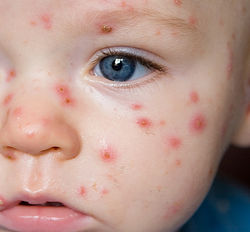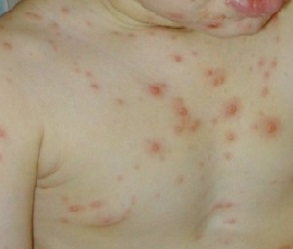 Chickenpox is an acute infectious disease caused by viruses of the herpes family. A distinctive feature - rashes on the skin in the form of small bubbles.It is very important not to allow a person to comb the formed bubbles, since after that scars may remain.
Chickenpox is an acute infectious disease caused by viruses of the herpes family. A distinctive feature - rashes on the skin in the form of small bubbles.It is very important not to allow a person to comb the formed bubbles, since after that scars may remain.
Children tend to tolerate the disease much easier than adults, in whom it can provoke various complications. A typical category of people who are affected by the virus are children from 1 to 10 years old, but the peak in the human population is at the age of 4 years.
A person can get chickenpox only once and in the future he develops persistent immunity for the rest of his life. With chicken pox in children, the first symptoms begin 1-3 weeks after infection, on the first day, the temperature begins to rise, after the body there are specific rashes - this is the initial stage of chickenpox, the treatment of which must be started in a timely manner.
How does the disease begin?
The chickenpox is so called, which can be carried by the wind, that is, by airborne droplets. Let's see how it manifests in children. Someone sneezes next to you infectious, you will already forget about this minor episode in your life. And in 1-3 weeks suddenly the temperature will rise. This is the initial stage of chickenpox in children (see Fig. a photo).
And if not for the almost simultaneous appearance of a rash, then this ailment could be taken for ARI, besides, the symptoms of chicken pox include headache and a sense of weakness. Now you know how the disease begins.
How can I get infected?
The source of infection is only sick with chickenpox, and only they, since this type of virus is not adapted to the external environment and perishes in just a few minutes, after it leaves the body.
It should also be noted that the source of infection is only the person who has chickenpox in active form. This stage begins 2 days before the first rashes appear on the body
Chickenpox photo: initial stage of rashes
To determine what the initial stage looks like, we suggest that you familiarize yourself with the photo. It shows the nature of the rashes.
The incubation period
The incubation period of chickenpox lasts from one to three weeks. At this time, the ailment does not manifest itself in any way and people do not even suspect that they themselves are sick, but the child or adult becomes Infectious for others since the virus enters it and until the appearance of the last rash on the skin. At this point, you already need to know how to treat chickenpox at home.
Symptoms of chickenpox in children
 In the case of chickenpox, the symptoms in children can not be confused with any other disease, since they manifest themselves in all their glory in a very short time. The main symptoms of chickenpox are:
In the case of chickenpox, the symptoms in children can not be confused with any other disease, since they manifest themselves in all their glory in a very short time. The main symptoms of chickenpox are:
- Chicken pox usually begins with fever, tremors, heat and general malaise.
- Flat rashes all over the body (except palms and feet), which rapidly cover the body (for 1-2 hours). Spots with a pea or millet seed, pink. At this stage, rashes do not bring the child or adult discomfort.
- A few hours later, the appearance in the center of the specks of a small bubble, inside which is a transparent content. The most unpleasant thing is that when the bubbles appear, the child begins to feel itchy and try to comb them. It is important to ensure that a person stops combing the affected skin, as it is possible to infect an infection.
- After 1-2 days, the blisters dry and cover with a brownish crust. However, simultaneously with this for another 7-10 days with an interval of 1-2 days there are new eruptions, which again are accompanied by a rise in temperature.
- In adults, the pustules rash for a long time, ulcers are formed, which heal for a long time, forming scars.
- At the end of the rash, the crusts come off within 1-2 weeks, after which there remains a slight pigmentation that disappears with time. If during the disease there were complications, for example, a pyogenic infection was introduced, then small scars remain on the skin.
All these signs are characteristic of chicken pox and occur in most children (regardless of how old they are). It is extremely important in the early days of the disease to recognize its symptoms, so as soon as possible to consult a doctor and begin treatment.
It is important not to confuse the sore with a common cold, which often happens in children and has similar symptoms (fever, weakness, headache). As soon as you notice the baby's first rashes on the body and other symptoms of chickenpox, you should immediately contact a specialist. The doctor will conduct differential diagnosis and tell you how to treat chickenpox at home.
In children, the disease proceeds in a simpler form than chicken pox in adults, which may later suffer from complications.
Treatment of chickenpox
When chickenpox, treatment in children is mostly symptomatic - treatment of skin rashes and accompanying symptoms is performed: external means are used that relieve pain and disinfecting rash, and antipyretic and analgesic are used. Accompany the treatment of antihistamines that relieve swelling and pain.
In severe general conditions and severe skin manifestations, hospitalization may be required, especially if symptoms appear from the side of the nervous system (pain giving to the feet, severe headache) or if the patient becomes hard to breathe.
An approximate scheme for treating chickenpox is as follows:
- The liquid bubbles must be lubricated several times a day with greens or a medicinal colorless liquid Kasteliani. This promotes faster drying of the vesicles and further formation of crusts that precede healing. In addition, this prevents the spread of infection through the body (see Fig. than smear of chickenpox except zelenki).
- Relieving symptoms, including itching. To do this, use antihistamines of systemic action, which, however, today become less popular, since the inhibition of the immune response, according to the assumptions, can lead to complications. With general symptoms of inflammation also seek to alleviate the patient's condition - to relieve pain and temperature, for which NSAIDs are recommended: paracetamol or ibuprofen.
- To reduce the temperature should take some antipyretic drugs, for example: Panadol (Paracetamol), Nurofen, Efferalgan. Aspirin is not recommended, especially for children under 10 years of age.
- Also, to quickly cure chickenpox should adhere to bed rest for the period of intoxication and high temperature.
In developed countries, instead of aniline dyes in combination with antihistamines, use Calamine Lotion, which helps to soothe the skin. Lotion is a soft antiseptic, dries new bubbles and promotes faster healing, and also protects the skin from irritating factors. Cools and soothes the combing sites, reducing the risk of scars and scars. It is clinically tested and certified on the territory of the Russian Federation.
Prevention of chicken pox
Currently, there is a vaccine against varicella.
Usually the patient is isolated at home. Isolation stops 5 days after the last rash. For children attending organized children's groups, there is an instruction for admission to children's institutions provided for in the instruction. Disinfection due to the instability of the virus is not carried out, sufficiently frequent airing and wet cleaning of the room.
Can I get sick a second time?
The virus of chickenpox belongs to the group of herpes viruses. And in fact, after suffering (usually in early childhood), the disease does not disappear from the body, but "falls asleep" in the secret parts of the spinal cord - the nervous ganglia.
A virus can wake up with a general decrease in immunity. Sometimes it gives the same symptoms as with classical chicken pox, sometimes provokes the so-called shingles (when the rash appears along the ribs - along the nerves).
How many days is contagious?
Determine the first day when chickenpox is contagious, you can hardly. 1-2 days before the onset of the rash, the infected person is already the carrier of this infection. Infect other people, he will be all the time, until his body will ripen vesicles.
A safe carrier is considered only after the last crust disappears. The contagious (infectious) period lasts approximately 10-14 days, during which time the infection of others occurs.
Graft
The vaccine sufficiently protects against chickenpox and its complications. It is recommended to be administered to children aged 12 months and older, as well as adolescents and adults who have not previously had chicken pox and who have not been vaccinated. The vaccine protects against the disease for 10 years or more. In rare cases, people who have been vaccinated against chicken pox can get chickenpox, but the disease will be mild.
Currently, in the United States, Japan and some other countries, this vaccination is mandatory for admission of the child to a preschool. But in Russia, the vaccination of children from chicken pox has not yet become widespread, and this remains the choice of parents.
It is worth noting that some people with a weakened immune system (as a result of illness or medication, influencing immunity) should not be vaccinated, because they may develop complications. Therefore, before receiving a vaccine for a patient with a weakened immune system, you should consult a physician.

How to choose probiotics for the intestine: a list of drugs.

Effective and inexpensive cough syrups for children and adults.

Modern non-steroidal anti-inflammatory drugs.

Review of tablets from the increased pressure of the new generation.
 Antiviral drugs are inexpensive and effective.
Antiviral drugs are inexpensive and effective.



